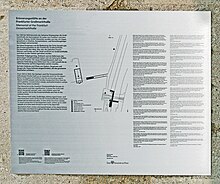Großmarkthalle station (Frankfurt am Main)
The Großmarkthalle station was the freight yard of the Großmarkthalle in Frankfurt 's Ostend district from 1928 to 2004 . As part of the new building for the European Central Bank, it was converted into a memorial at the Frankfurt wholesale market hall and has been open to the public since November 22, 2015.
meaning
The commercial wholesale market , in which mainly fruit and vegetables were traded, had a considerable volume of goods traffic , which - from the 1950s onwards, with a decreasing tendency - was to a large extent reached by rail . The freight yard was located on the municipal connection line , which connected it to the Frankfurt – Hanau railway to the east and, via the Frankfurt-Griesheim station , to the Main-Lahn railway to the west. With the abandonment of the wholesale market hall in 2004, the station was abandoned and the track system was then removed.
Deportations
From October 1941, the National Socialists used the basement of the Grossmarkthalle as a collection point and the freight yard for the deportation of Jewish men, women and children from Frankfurt and the surrounding area. These transports from the goods station in the wholesale market hall - mostly to the Theresienstadt concentration camp - played an important role in the genocide within the machinery of extermination of the Holocaust . In total, over 11,000 people were deported in 10 larger and 18 smaller transports by February 1945, of which only about 300 survived. A memorial plaque has been commemorating this since 1997 .
On November 22, 2015, the memorial at the Frankfurt wholesale market hall was opened at this historic location . Part of the memorial is located on the extraterritorial grounds of the European Central Bank and can only be viewed as part of guided tours offered by the Jewish Museum Frankfurt . There is also a publicly accessible area along the railway embankment between Sonnemannstrasse and the banks of the Main.
post war period

In 1945, after the end of World War II , all Frankfurt Railway bridge over the Main were destroyed and due to the debris and damage to the operating systems and the trams in Frankfurt city center had stopped running, the acquired Urban Verbindungsbahn importance for urban and local Transport : It was the only usable rail link between the western and eastern tracks of the city. This is how modest passenger transport came about: The Frankfurt-Königsteiner Eisenbahn (FKE) ran its trains from July 13th to September 30th, 1945 from the Taunus via the stations Frankfurt-Höchst , Fahrtor , Großmarkthalle - which became a passenger station for such a short time - and Riederhöfe to the station Frankfurt-Mainkur . After this connection was discontinued, this stop was opened again for passenger traffic. In April 2015, the “ European Central Bank ” stop was set up by the Frankfurt Historical Railway (HEF).
literature
- Walter Bachmann: Frankfurt wholesale market hall. Frankfurt 2001: JW-Verlag, ISBN 3-934354-02-5 .
- Andreas Christopher and Gerd Wolff, German small and private railways. Volume 8: Hesse. Freiburg 2004, ISBN 3-88255-667-6 .
- Railway in Hessen. Cultural monuments in Hessen. Monument topography Federal Republic of Germany, ed. from the State Office for Monument Preservation Hessen, Theiss Verlag, Stuttgart 2005, 3 volumes in a slipcase, 1,448 pages, ISBN 3-8062-1917-6 .
- Railway Atlas Germany - Edition 2005/2006, Vlg. Schweers + Wall, o. O. 2005, ISBN 3-89494-134-0 .
- Heinz Hirt: 1877–2002 - 125 years of the Main-Lahn-Bahn Höchst-Limburg. Eppstein (Taunus) 2002, ISBN 3-00-010714-2 .
- Wolf-Christian Setzepfandt : Architecture Guide Frankfurt am Main / Architectural Guide . 3. Edition. Dietrich Reimer Verlag, Berlin 2002, ISBN 3-496-01236-6 , p. 44 (German, English).
- City Planning Office Frankfurt am Main (ed.): ZwischenZeit. Snapshots of the Frankfurt wholesale market hall. Frankfurt am Main 2008: City of Frankfurt am Main.
Individual evidence
- ^ Jewish Museum Frankfurt
- ↑ urban and nature
- ^ Deportation of Jews from Frankfurt am Main 1941–1945. In: Frankfurt 1933–1945. Institute for Urban History , accessed on November 6, 2014 .
- ↑ Memorial plaque on the Grossmarkthalle ( memento from September 24, 2015 in the Internet Archive ), documented on the website of the Institute for Urban History
- ↑ Memorial for the victims of the deportations at par.frankfurt.de , the former website of the city of Frankfurt am Main
- ↑ Friederike Tinnappel: The memorial should also remember the perpetrators. In: FR online. November 22, 2015, accessed November 23, 2015 .
- ↑ Security requirements make access to the memorial difficult. faz.net, February 15, 2016, accessed February 21, 2016 .
- ↑ Guided tours for groups Memorial site at the wholesale market hall
- ↑ A copy of a corresponding timetable was on view in the exhibition 150 Years of the Port Railway on July 11 and 12, 2009 in the Osthafen station .
- ↑ Marvin Christ, Wilfried Staub: Newsletter of the Historical Railway Frankfurt (HEF) No. 75 . Ed .: Historical Railway Frankfurt e. V. Frankfurt May 13, 2015, p. 5-6 .
Coordinates: 50 ° 6 ′ 34 ″ N , 8 ° 42 ′ 9 ″ E

